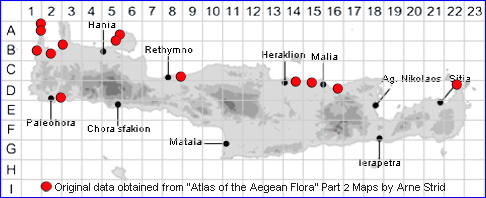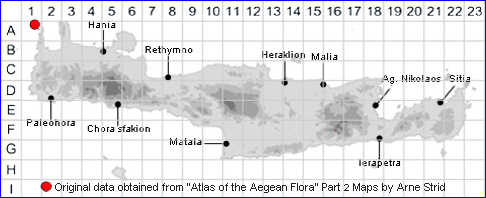
SPECIES DESCRIPTION
LIMONIUM SIEBERI
Family:- PLUMBAGINACEAE
Common Names:- None
Synonyms:- Statice graeca var. sieberi, Statice sieberi.
Meaning:- Limonium (Gr) Meadow-plant. A name used by the Greek physician
and botanist Dioscorides.
Sieberi (L) For the botanist Franz Wilhelm Sieber (1785-1844).
General description:- Perennial, forming small tufts, with a stout, branched woody
stock.
Stems:-
a) 15-30 cm.
b) few, erect, slender.
c) with few, long branches.
Leaves:-
1) Basal:
a) 20-45 x 4-10 mm.
b) oblanceolate to spathulate, obtuse and often mucronate at the apex.
c) rather thick and rigid, with l main vein and sometimes 2 weak lateral veins.
d) greyish-green to glaucous.
e) finely tuberculate.
Flowers:-
1) Spikes lax.
2) Spikelets:
a) 8-10 mm.
b) 1-or 2-flowered.
3) Bracts rusty-brown.
4) Calyx 5.5-8 mm.
a) appressed-pilose.
b) lobes broadly ovate, obtuse.
5) Corolla pale violet.
Habitat:- Mainly on rocky limestone coasts, rarely in dry open shrubby vegetation,
some distance inland up to 200 m.
Distribution:- Almost restricted to Aegean area,- just extending to S Peloponnisos
and SW Anatolia.
Flowering time:- May-July, occasionally later.
Photos by:-
FAMILY AND GENUS DESCRIPTIONS
PLUMBAGINACEAE
General description:- Herbs or shrubs.
Leaves:- Alternate or in basal rosettes, exstipulate.
Flowers:- Inflorescence usually cymose, often contracted into a capitulum, rarely
spike-like. Flowers actinomorphic, 5-merous, usually in bracteate spikelets. Calyx
tubular below, toothed (dentate) or lobed and at least slightly thin and dry (scarious)
and often pleated (plicate) distally, persistent. Petals united (connate) only at the
base, or the corolla with a usually short tube. Stamens united with the petals
(epipetalous). Styles 5, or 1 with 5 stigma-lobes. Ovary superior, 1-locular.
Fruit:- Dry, membranous, 1-seeded, surrounded by calyx, not splitting open to
release their seeds (indehiscent) or with circumscissile or irregular dehiscence.
LIMONIUM
General description:- Perennial, rarely annual, herbs or dwarf shrubs.
Leaves:- Simple, usually in a basal rosette, but densely leafy branches sometimes
present; leaves often absent at anthesis.
Flowers:- Inflorescence a corymbose panicle, with terminal, secund spikes, often
with non-flowering branches, usually with a reddish scale at the base of each
branch. Spikes of 3-bracteate, 1- to 5-flowered spikelets; inner and outer bracts
external to the spikelet, the middle one internal and often inconspicuous. Calyx
funnel-shaped (infundibuliform); limb thin and dry (scarious), usually coloured,
sometimes shortly dentate between the lobes. Corolla with a short tube, or the
petals united (connate) only at the base. Stamens inserted at the base of the
corolla. Styles 5, glabrous, free or connate at the base; stigmas thread-like
(filiform).
Fruit:- With circumscissile (opening by a slit running around the circumference) or
irregular splitting open to release the seeds (dehiscence).
1) Calyx infundibuliform.
2) Stamens inserted in base of corolla.
3) Styles 5, free or connate in basal half.
4) Fruit circumscissile towards apex or with irregular dehiscence.
5) Corolla-tube much shorter than lobes.
6) Spikes secund, the terminal not distinctly larger.
7) Stigmas filiform.
LIMONIUM GRABUSAE
Synonyms:- None
Meaning:- (L) Named after Grabusa (= Gramvousa), an islet near northwest Crete.
L. grabusae Erben & Brullo, ined. based on a single collections from W Crete, and is unlikely to be specifically distinct from L. sieberi. 1)
Click here for a more detailed description of this species.
1) "Atlas of the Aegean Flora" Book1, Arne Strid 2016.
Habitat:- Calcareous rocky coast.
Distribution:- Restricted to Gramvousa, islet of northwest Crete
Flowering time:- May-July
Photos:- Unavailable
Synonyms:- None
Meaning:- (L) Named after Grabusa (= Gramvousa), an islet near northwest Crete.
L. grabusae Erben & Brullo, ined. based on a single collections from W Crete, and is unlikely to be specifically distinct from L. sieberi. 1)
Click here for a more detailed description of this species.
1) "Atlas of the Aegean Flora" Book1, Arne Strid 2016.
Habitat:- Calcareous rocky coast.
Distribution:- Restricted to Gramvousa, islet of northwest Crete
Flowering time:- May-July
Photos:- Unavailable

